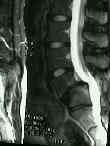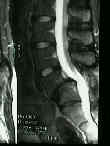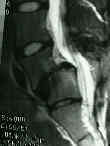- Exam:
- Radiographs:



- Treatment:
- these pts have a high deg of lumbosacral kyphosis have sig deformity;
- prophylactic fusion in children & adolescents w/ slippage > 50% is recommended;
- w/ a L-5 to S-1 spondylolisthesis, treatment consists of bilateral posterolateral arthrodesis in situfrom L4 to S1 w/ or w/o instrumentation;
- hence, transverse processes of 4th lumbar vertebra is included in fusion;
- fusion to L4 is required, for increased stability and because the L4 disc will become degenerative by middle age;
- reduction:
- most children & adolescents w/ grade III & even grade IV slips do not require reduction of the displacement;
- they almost always can be managed successfully by posterior- posterolateral fusion of L4 to S1 and cast immobilization;
- pitfalls:
- do not confuse the L5 transverse process w/ L4 transverse process (use intraoperative flouroscopy);
- give special attention to thorough cleaning out and bone grafting of the L5 transverse process-alar interval;
- postop:
- in the past, some surgeons have recommended 2 to 4 wks of halo-femoral traction in mild hyperextension, followed by 4 to 6 mo
of bed rest in a double pantoloon cast;
- w/ recent improvements in pedicle screw fixation, patients can be mobilized postoperatively if they are fitted w/ a well molded
spinal orthosis;
- Cauda Equina Syndrome:
- occurrence of acute cauda equina syndrome after in situ arthrodesis for spondylolisthesis has been reported;
- preop evaluation for clinically unapparent neurogenic bladder in patients with grades III & IV spondylolisthesis is recommended;
- if cauda equina syndrome occurs after arthrodesis in situ, post. aspect of S-1 vertebral body should be removed;
- partial reduction of spondylolisthesis is also considered
Staged salvage reconstruction of grade-IV and V spondylolisthesis.
Failed arthrodesis of the spine for severe spondylolisthesis. Salvage by interbody arthrodesis.
Management of severe spondylolisthesis in children and adolescents.
Severe spondylolisthesis in children and adolescents. A long-term review of fusion in situ.
Severe spondylolisthesis. Reduction and internal fixation.

